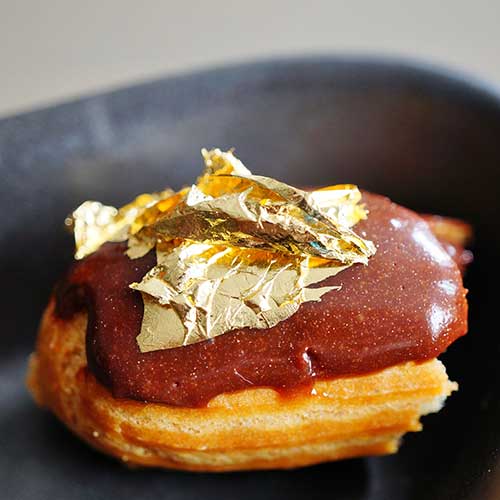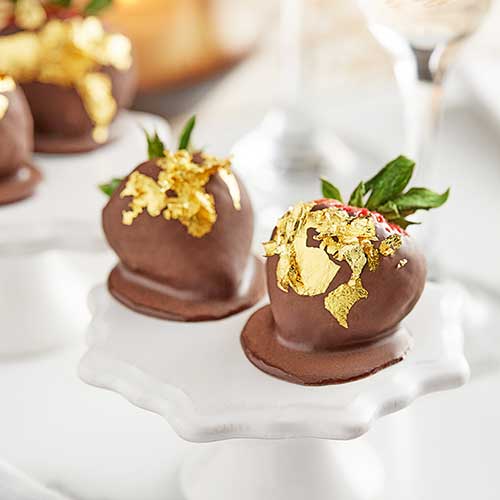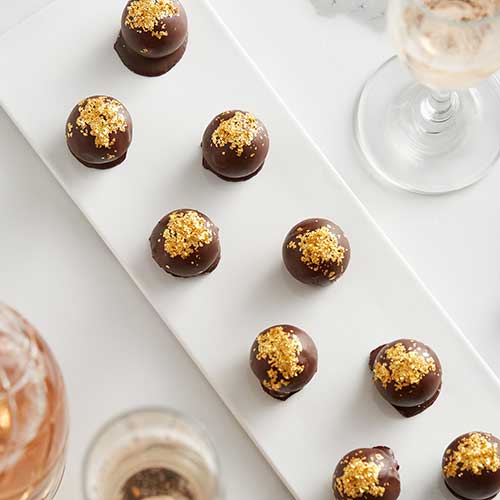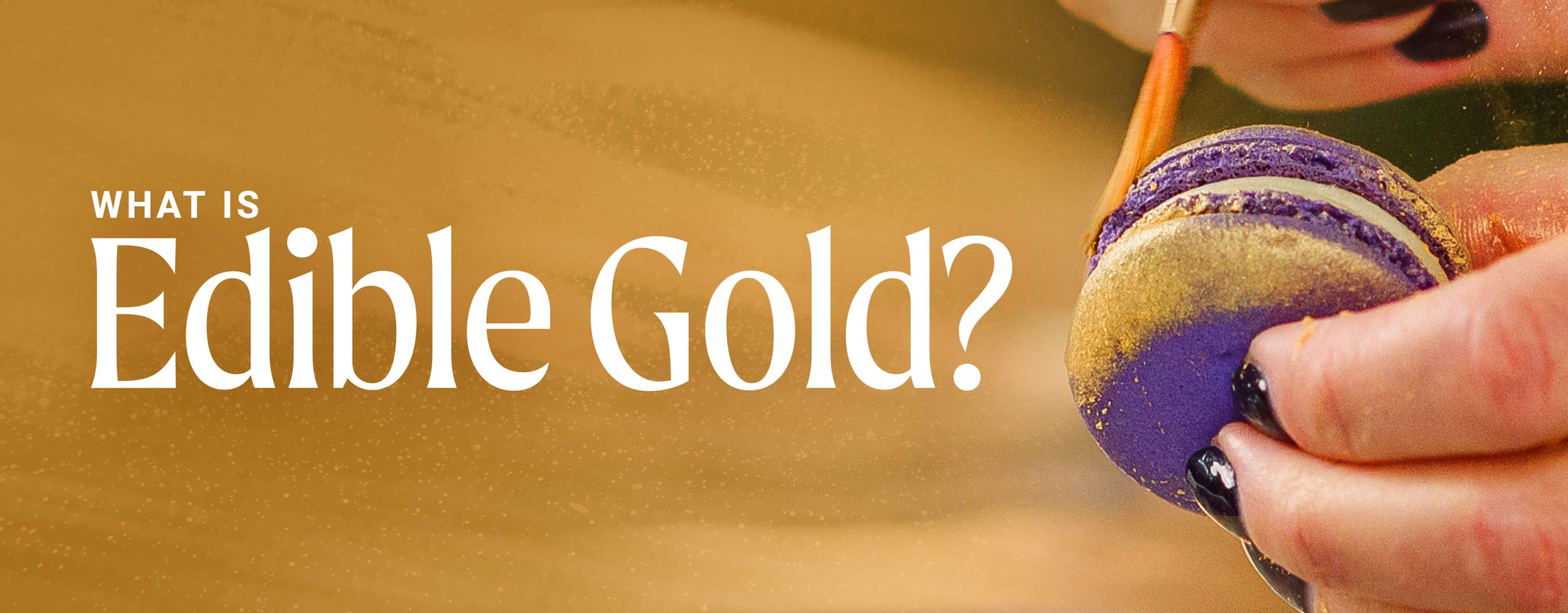Despite rising prices, or perhaps because of them, people are increasingly interested in luxury dining experiences and ingredients, choosing to eat out less often but treating it like a special occasion when they do. Whether you're just daydreaming about how the 1% eat, or you're looking for affordable alternatives to bougie ingredients, we've created a guide to the most expensive foods in the world. From exotic fruits and coffee beans to premium beef and caviar, use the finest global fare as inspiration for creative innovation. Learn about the most expensive foods in the world: 1. Saffron 2. Wagyu Beef 3. Kopi Luwak Coffee 4. Bluefin Tuna 5. Kobe Beef 6. Beluga Caviar 7. Densuke Watermelon 8. Iberico Ham 9. Edible Gold 10. White Alba Truffles 1. Saffron Saffron is a highly prized spice harvested from the stigma of the Crocus sativus flower. Made from the dried styles of the flower, also known as threads, harvesting saffron requires a significant amount of labor. In addition to the meticulous sourcing process, each flower only produces a small amount of saffron. This disparity in supply and demand creates its notoriously high price tag (averaging between $5 and $20 per gram). Saffron imparts a subtly sweet and floral flavor with hints of honey and hay. Its aroma is equally distinctive, adding a rich and earthy quality to dishes. Due to its potency, a little saffron goes a long way. When using saffron, it is essential to infuse the threads in warm liquid to extract their full flavor and color. It's a common ingredient in dishes such as paella, risotto, and bouillabaisse. Not just for savory applications, saffron is a key ingredient in traditional desserts, such as Scandinavian St. Lucia buns and Persian saffron ice cream. For those seeking a budget-friendly alternative to saffron, turmeric can be used as a natural food coloring agent, achieving a similar golden hue in dishes. While turmeric lacks the nuanced flavor profile of saffron, it can provide a comparable color at a fraction of the cost. Additionally, you can substitute safflower petals, marigold petals, and annatto seeds for saffron and achieve a similar visual appeal. Average Saffron Price: $5 to $20 per gram Why Is Saffron Expensive? Made from dried styles of Crocus sativus flower, with few per flower, and a time-consuming harvesting process Saffron Tasting Notes: Floral, subtly sweet, earthy, warm, aromatic Dishes That Use Saffron: Paella, risotto, bouillabaisse, St. Lucia buns, Persian saffron ice cream Less Expensive Alternative to Saffron: Turmeric, safflower petals, marigold petals, annatto seeds 2. Wagyu Beef Originating in Japan, Wagyu cattle are bred and raised with meticulous care to produce meat of unparalleled quality. The term Wagyu translates to "Japanese cow," and the breed is renowned worldwide for its superior meat. The high price tag attached to Wagyu beef (averaging between $50 and $150 per pound) attributed to several factors. Firstly, the rearing process of Wagyu cattle is extensive and arduous, involving special diets, strict regulations, and individualized attention to ensure the desired marbling and tenderness in the meat. The limited supply of authentic Wagyu beef drives up its cost, as only a small percentage of beef worldwide meets the stringent Wagyu classification standards. When it comes to taste, Wagyu beef is known for its exceptional buttery texture and intense umami flavor. The marbling of fat within the meat contributes to its succulence, making it a favorite among private chefs and food enthusiasts. Popular dishes that showcase the richness of Wagyu beef include Wagyu steak, Wagyu burgers, Wagyu beef sushi, and Wagyu beef carpaccio. For those looking to experience the luxurious taste of Wagyu beef without the hefty price tag, American Wagyu, a crossbreed of Wagyu and American cattle, offers a more affordable option that still delivers a similar level of marbling and flavor. High-quality cuts of prime beef, such as ribeye or filet mignon, offer a comparable taste experience to Wagyu beef at a lower cost. Average Wagyu Beef Price: $50 to $150 per pound Why Is Wagyu Beef Expensive? High Wagyu beef classification standards create a limited supply and high demand Wagyu Beef Tasting Notes: Rich, umami, buttery Dishes That Use Wagyu Beef: Wagyu beef steaks, Wagyu beef burgers, Wagyu beef sushi, and Wagyu beef carpaccio Less Expensive Alternative to Wagyu Beef: American Wagyu, ribeye, filet mignon 3. Kopi Luwak Coffee Kopi Luwak coffee, also known as civet coffee, is made from coffee beans that have been eaten, digested, and excreted by the Asian palm civet, a small mammal native to Southeast Asia. The beans are collected from the civet's droppings, thoroughly cleaned, and roasted to produce the distinctive Kopi Luwak coffee. The high price tag of Kopi Luwak coffee (between $50 and $100 when farmed and $300+ when wild) is primarily due to the labor-intensive process involved in its production. The civets are selective in choosing the ripest and best coffee cherries to eat, and their digestive enzymes ferment the beans, resulting in a smoother and less acidic flavor profile. Additionally, the scarcity of civet coffee production further drives up its price, as the beans are collected in small quantities and processed with great care. The fermentation process in the civet's digestive system contributes to the coffee's mellow and less bitter taste compared to traditional coffee varieties. Kopi Luwak coffee is known for its smooth, rich, and earthy flavor with hints of chocolate and caramel notes. For a coffee and food pairing, Kopi Luwak complements dark chocolate, caramelized desserts, and nutty pastries as well as coffee treats like tiramisu and coffee cake. To experience an exotic coffee flavor without the hefty price tag of Kopi Luwak, Jamaican Blue Mountain coffee, Hawaiian Kona coffee, and Ethiopian Yirgacheffe coffee are good alternatives. Average Kopi Luwak Coffee Price: Farmed: $50 to $100, Wild: $300+ Why Is Kopi Luwak Coffee Expensive? Produced from coffee beans that were digested and excreted by an Asian palm civet Kopi Luwak Coffee Tasting Notes: Mellow, sweet chocolate and caramel essences Kopi Luwak Coffee Pairing: Dark chocolate, caramelized desserts, tiramisu, cheese platter, coffee cake, baklava Less Expensive Alternatives to Kopi Luwak: Jamaican Blue Mountain coffee, Hawaiian Kona coffee, Ethiopian Yirgacheffe coffee 4. Bluefin Tuna Known for its rich flavor and buttery texture, bluefin tuna is one of the most expensive foods in the world due to its scarcity and high demand in the global market. The main reason behind the exorbitant price of bluefin tuna (averaging around $170 per pound) is its dwindling population. Overfishing and environmental factors have severely depleted the bluefin tuna population, leading to strict regulations on its harvesting. This scarcity, combined with the high demand for bluefin tuna in sushi and sashimi dishes, contributes to its premium price tag. Bluefin tuna is prized for its distinct flavor profile, which is often described as rich, succulent, and sweet. The high fat content of bluefin tuna gives it a tender texture paired with a dense, steak-like quality, making it perfect for raw preparations like sushi, sashimi, and crudo that showcase its quality and freshness. Bluefin tuna can also be seared, grilled, or served as a tartare to highlight its versatility and unique taste. For those looking to enjoy the flavors of tuna at a lower cost, yellowfin and albacore tuna are popular choices that offer a similar taste and texture. Average Bluefin Tuna Price: $200 to $400 per pound Why Is Bluefin Tuna Expensive? Overfishing and sustainability concerns Bluefin Tuna Tasting Notes: Rich, meaty, slightly sweet flavor with a steak-like texture that melts in your mouth Dishes That Use Bluefin Tuna: Sushi, sashimi, crudo, tartare, and poke Less Expensive Alternatives to Bluefin Tuna: Yellowfin tuna, albacore tuna 5. Kobe Beef Originating from Hyogo Prefecture in Japan, and renowned for its unparalleled tenderness, marbling, and flavor, Kobe beef is subject to strict regulations governing its production, ensuring each cut meets the highest standards of quality. Its high price tag (averaging between $200 and $500 per pound) is due in part to the meticulous and time-consuming rearing process for Kobe cattle. These cattle are raised in a stress-free environment, fed a special diet that includes beer and grains, and even massaged to ensure their muscles remain tender. Additionally, the limited supply of authentic Kobe beef further drives up its price, as only a select number of cattle meet the stringent criteria to be classified as Kobe beef. The taste of Kobe beef is truly exceptional, characterized by its rich, buttery texture and intense umami flavor. The high level of marbling in Kobe beef results in a melt-in-your-mouth experience that is unmatched by any other type of beef. When cooked to perfection, Kobe beef boasts a delicate balance of savory and sweet notes. From succulent Kobe beef steaks and burgers to luxurious beef tartare and sushi, the possibilities are nearly endless. It's the star in many Asian dishes like teppanyaki, shabu-shabu, and sukiyaki. For a premium cut of beef that comes at a lower price tag, high-quality cuts of domestic beef, such as USDA Prime or Choice, can provide a comparable level of flavor and tenderness at a fraction of the cost of Kobe beef. Average Kobe Beef Price: $200 to $500 per pound Why Is Kobe Beef Expensive? Meticulous production leading to a small supply and large demand Kobe Beef Tasting Notes: Savory, slightly sweet, with delicate floral essences and a buttery texture Dishes That Use Kobe Beef: Steak, teppanyaki, shabu-shabu, sukiyaki, sashimi Less Expensive Alternatives to Kobe Beef: USDA Prime or Choice 6. Beluga Caviar Beluga caviar is the roe (eggs) of the beluga sturgeon, a species of fish found primarily in the Caspian Sea. It's highly sought after for its large, luscious eggs that range in color from light to dark gray. The exorbitant price tag of beluga caviar (averaging between $200 and $300 per ounce) is no surprise since the beluga sturgeon takes a long time to reach maturity, typically around 20 years, before it can be harvested for its eggs. Additionally, overfishing and habitat destruction have led to a decline in wild beluga sturgeon populations, making the caviar even more scarce and expensive. Because beluga sturgeon are endangered, beluga caviar is outlawed in the US. Hybrid beluga caviar, made by crossbreeding Beluga caviar with another sturgeon species, is available for purchase. Beluga caviar offers a delicate, buttery flavor and creamy texture. The eggs are known for their distinct, nutty taste layered over a delicate, buttery consistency that leaves a lingering umami richness. Beluga caviar is often served simply on blinis or toast points, allowing the caviar's flavor to shine. It is also commonly used to garnish dishes such as deviled eggs, oysters, and sushi for a touch of elegance and sophistication. Popular alternatives to beluga caviar that provide a comparable taste and texture are American paddlefish caviar and salmon roe. Average Beluga Caviar Price: $200 to $300 per ounce Why Is Beluga Caviar Expensive? Beluga sturgeon take a long time to come to maturity, and overfishing Beluga Caviar Tasting Notes: Creamy and rich with a nutty finish Dishes That Use Beluga Caviar: Served simply on blinis or toast points, or as a garnish for oysters, sushi, or deviled eggs Less Expensive Alternatives to Beluga Caviar: American paddlefish caviar, salmon roe 7. Densuke Watermelon Originating from the island of Hokkaido in Japan, Densuke watermelons are a black watermelon variety. They're prized for their onyx rind, bright red flesh, firm texture, and exceptional sweetness by collectors worldwide. This premium watermelon variety is meticulously cultivated in limited quantities. As few as 10,000 Densuke watermelons are harvested each year. The scarcity of Densuke watermelon, coupled with its exceptional taste and visual appeal, contributes to its high price point (around $250 per watermelon). Thanks to their high sugar content, Densuke watermelons are significantly sweeter than traditional watermelons. From refreshing salads, agua fresca, and cocktails to decadent desserts and sorbets, Densuke watermelon can be used in a myriad of culinary applications to showcase its unique taste and visual appeal. Perhaps its best application is as a buffet centerpiece at a high-end catered event. Since Densuke watermelon's price point may not be accessible to all consumers, other watermelon varieties, such as Crimson Sweet or Sugar Baby, can offer a similar sweet and juicy flavor profile. Average Densuke Watermelon Price: $250 Why Is Densuke Watermelon Expensive? Meticulous cultivation, limited production, and high demand Densuke Watermelon Tasting Notes: Honeyed flavor and crisp texture Dishes That Use Densuke Watermelon: Best enjoyed on its own, can be used in drinks and frozen treats Less Expensive Alternatives to Densuke Watermelon: Crimson Sweet watermelon or Sugar Baby watermelon 8. Iberico Ham Iberico ham, also known as Jamon Iberico, is a premium ham variety originating from Spain. Made from the meat of the Iberian pig, this delicacy is renowned for its unparalleled flavor and texture. Standard, hind-leg, acorn-fed 100% Iberico ham averages between $57 and $60 per pound, and premium brands cost between $80 and $110 per pound. The pigs used to make Iberico ham are raised in specific regions of Spain and Portugal, where they are allowed to roam freely and feed on a diet of acorns, which contributes to the unique flavor profile of the meat. The curing process can take several years, during which the hams are carefully monitored and aged to perfection. Iberico ham is known for its rich, nutty flavor and melt-in-your-mouth texture. The meat is marbled with flavorful fat, giving it a luxurious and indulgent taste that is unlike any other type of ham. Its complex flavor profile often features notes of sweetness, saltiness, and a hint of smokiness. Shoulder cuts of Iberico ham are more affordable, averaging between $38 and $46 per pound. To experience a similar flavor as Iberico ham at a lower price point, Serrano ham, also from Spain, is a popular choice. Prosciutto, an Italian cured ham, is another excellent alternative. While neither Serrano ham nor prosciutto will precisely mimic the coveted Iberico ham flavor, they offer a delicious and more budget-friendly option for creating a premium charcuterie board that may be a splurge for the average consumer but can still be considered an affordable luxury. Average Iberico Ham Price: $77 per pound Why Is Iberico Ham Expensive? Sourced from a specific breed of Spanish regional pigs raised on a specialized acorn diet, and the meat undergoes a prolonged, labor-intensive production process Iberico Ham Tasting Notes: Nutty, sweet, umami with a buttery texture Dishes That Use Iberico Ham: Charcuterie boards, croquettes, huevos rotos, various Spanish tapas Less Expensive Alternatives to Iberico Ham: Serrano ham, prosciutto 9. Edible Gold Edible gold, also known as food-grade gold, is safe for consumption and used as a decorative element in high-end cuisine and beverages. Edible gold is typically made by evaporating gold into thin sheets that are then carefully crafted into flakes or powder. The purity of the gold, as well as the meticulous process of creating edible gold, contribute to its high price tag. Edible gold is flavorless and odorless, making it an ideal ingredient for enhancing the visual appeal of dishes without altering their taste. Whether you're looking to add a touch of luxury to your plating presentation, create extravagant cocktails, or elegant desserts, edible gold is a decadent ingredient that can elevate the visual appeal of any dish or beverage. To achieve a similar luxurious effect without the high cost of edible gold, consider using edible silver, edible glitter, and edible pearl dust. These alternatives are safe for consumption and can be used in distinct culinary applications to create stunning presentations. Average Edible Gold Price: $2.50 per sheet Why Is Edible Gold Expensive? The cost of the gold itself, paired with its production process to turn it into an edible garnish Edible Gold Tasting Notes: Flavorless and odorless Dishes That Edible Gold: Garnish for chocolates, pastries, sushi, foie gras, and cocktails Less Expensive Alternatives to Edible Gold: Edible silver, edible glitter, and edible pearl dust 10. White Alba Truffles White Alba truffles, also known as white truffles or Tuber magnatum, are rare fungi primarily found in the Piedmont region of Italy. They are primarily harvested from the roots of oak, poplar, linden, and hazelnut trees. The high price tag of white Alba truffles (averaging around $328 per ounce) can be attributed to their scarcity and the arduous process of hunting and harvesting them. Unlike black truffles, which can be cultivated, white truffles must be foraged by specially trained dogs or pigs, adding to their exclusivity. White Alba truffles are renowned for their distinctive aroma, often described as a combination of garlic, shallots, and earthy notes. Their flavor is intense and complex, adding a unique umami richness to dishes. When using white Alba truffles in culinary applications, simplicity is key. Shave the truffles thinly over pasta, risotto, or scrambled eggs to fully appreciate their flavor. Cooking white truffles can diminish their aroma, so it's best to add them to dishes just before serving. To offer the luxury of truffles at a lower price point, consider using truffle products like truffle oil, truffle butter, or truffle salt. You can even substitute them for black truffles to achieve a similar taste profile in your dishes. While these options may not fully replicate the unique flavor of white Alba truffles, they can still elevate your culinary creations. Average White Alba Truffles Price: $328 per ounce Why Are White Alba Truffles Expensive: Scarcity, foraged by specially trained animals White Alba Truffles Tasting Notes: Garlic, earthy, nutty Dishes That Use White Alba Truffles: Garnish for risotto, pasta, or scrambled eggs Less Expensive Alternatives to White Alba Truffles: Truffle oil, truffle salt, truffle butter, black truffles Back to Top While indulging in the most expensive foods in the world can be a luxurious experience, it may not always be practical for every business budget. However, this doesn't mean you have to miss out on the unique flavors and culinary experiences that these high-priced items offer. Consider exploring less expensive alternatives that can still provide exceptional quality and taste. Use this list of ingredients and products to infuse creativity into your culinary endeavors. Disclaimer: The average ingredient prices were current as of July 2025.












